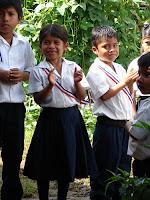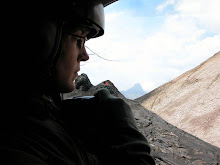The Year On Campus 06-07
The PCMI program (Peace Corps Master's International) on campus is actually fairly old. I learned that the Forestry Department and the Engineers (both Civil and Environmental) have been collaborating with the PC for more than 10 years. Currently, the university is developing a Science Education program that will also partner with Peace Corps, but for the moment, the Geology Department is the youngest MI program on campus. We're the pioneers: Woohoo!

_________________________________________________________________

The autumn weather in this part of the world is beautiful. Upper Peninsula weather is "special" and most would agree it's a bit infamous, but before the layers of snow close in, the warm September days are powerfully distracting as the semester begins. Like a classic New England autumn, the maples create a spectacle and follow up with a heaping mess of fallen leaves - the transition is gorgeous.
While worrying about course-load, Peace Corps paperwork, and how to prepare for a 2-year experience in a developing country, I met a lot of great people juggling the same stresses. The geo MIs made up a tight but small group, so I enjoyed sneaking into the events/gatherings of the engineers and foresters. This was especially easy since my housemates were a wonderfully mixed lot: returned volunteers, aspiring volunteers, and adopted PCMI (yes, that's you Dhita). We weren't the only house near campus that focused so much PC power, the 900 House was another magnet for us. Theme parties (the '80s will never die), socials (Jack's movie selection was topnotch!), study sessions (oh GIS), a Thanksgiving extravaganza (special thanks to Matt's Mom&Dad!), Christmas tree management (Panchita and Dhita had a vision), and overflowing washermachine events remain fixed in my memory of domestic life.
_______________________________________________________________
How new is my program? New enough that the first wave of students hadn't yet returned from Peace Corps service to defend their thesis. It was possible to email the far-field students, but it was a tough way to get an introduction; this meant that very bit of advice and quickly-typed explanation helped immensely. It's not possible to feel completely prepared for the upcoming experience, but certainly over the course of 2 semesters it's possible to adjust to what is "knowable" and "unknowable." For example...
Knowable:
1. When the PC invitation letter arrives, you will celebrate.
2. When the final exams are over, you will celebrate.
3. When the Spanish skit with ghosts and jungles ends, you will celebrate.
4. When your advisor says: we'll support you, you will celebrate.

Unknowable:
1. What country you will serve in.
2. What language you should practice.
3. What thesis topic you will develop.
4. When the PC assignment will arrive.
Important Lesson:
Know when to celebrate.
_________________________________________________________________
Winter Carnival on Campus:
Too famous to brush over, too important to forget photos! I could fill up a webpage full of all of the photos I took - but I won't, the university is maintaining a perfectly good site here:
http://www.mtu.edu/carnival/gallery/ I didn't try broomball, but the MTU winter was great fun. Hockey games, cross-country skiing, snowshoeing (thanks for the invitation Jim!), ice skating (you got better Matt), shoveling, hot chocolate, snow sculpture-touring ... I feel pretty good about the winter semester. I could have done without the Calculus class, but I think we all knew that from the get-go.

_________________________________________________________________
During both semesters, it wasn't possible to stop mulling over what the next year abroad would be like. Above all possible questions the bothered me the most, I desperately wanted to know if my country of service would offer me
volcanoes. I wasn't particularly bothered by the prospect of learning an obscure new language or if I would have to cross piranha-filled rivers someday in order to reach potable water; no, I had more serious concerns. Will I have a volcano to study? This was an "unknowable," a terrible, terrible "unknowable."
Since my geology program focuses on Central American geologic hazards, I felt very comfortable with the prospect of narrowing my mulling activities to 14 countries due south of the United States. Early in the Fall Semester, I took on a project that would appear to have no definite end: a webpage.
As an attempt to both brainstorm what my future work/world would be like, I began a site that could provide information about what volcanic conditions exist in both South and Central American countries. The scope was a bit ridiculous, but I adopted a plan to post what material could possibly help me while I volunteer in the "unknowable" country. We shall see just how helpful this proves to be!

_________________________________________________________________
Peace Corps Details:
The application process is long and often painful for aspirants, but I believe that I was spared quite a bit of heartache. Not many complications existed with my forms: I applied to Michigan Tech in Dec. 2005 and didn't click "Send" to complete the Peace Corps online application until August 28th, 2006 before moving to campus. My official interview was held on campus sometime in November (then stretched to a telephone conversation) and the medical checkups happened fairly easily across the Portage. The acceptance letter showed up in December, the assignment details appeared in mid-March.
Mid-March, yes! This was fairly early but certainly felt far too drawn out at the time. Was the post a surprise? Yes to that as well.
 Trip to Volcan Baru (a very cold and very wet trip). I´ll share the drier photos here, but 90% of our trip was spent soaked through and colder than I´d like to remember.
Trip to Volcan Baru (a very cold and very wet trip). I´ll share the drier photos here, but 90% of our trip was spent soaked through and colder than I´d like to remember.


 d. If we had planned to hike just a week or two later, our odds would have been better for a dry time. The trouble is, though, that we ¨should have¨ just waited to hike on the 26th instead of the 24th and then, also, our rain problem would not have existed. So let that be a lesson! It´s still near-impossible to plan around the weather.
d. If we had planned to hike just a week or two later, our odds would have been better for a dry time. The trouble is, though, that we ¨should have¨ just waited to hike on the 26th instead of the 24th and then, also, our rain problem would not have existed. So let that be a lesson! It´s still near-impossible to plan around the weather. Also had a chance to work with PCMI Jessica and Adam uphill from me. Their composting latrine project is a large-scale event! So 2 days were spent mixing, blocking, and constructing the bases of latrines. Several of my community members wanted to
Also had a chance to work with PCMI Jessica and Adam uphill from me. Their composting latrine project is a large-scale event! So 2 days were spent mixing, blocking, and constructing the bases of latrines. Several of my community members wanted to 




































